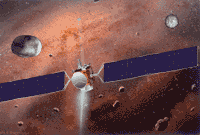ASTEROIDS
 Click to enlarge NASA artist concept of Dawn with Vesta and Ceres |
The deep space probe now is expected to be launched in Summer 2007. If so, the craft then could arrive at Vesta in 2011 and Ceres in 2015.
Unfortunately, after years of preparing for a June 2006 launch, NASA cancelled the Dawn mission in March 2006.
Dawn would have flown for nine years on its journey to orbit the two most massive asteroids known, Vesta and Ceres. Those two "baby planets," located in the main Asteroid Belt between Mars and Jupiter, are very different from each other, yet both contain tantalizing clues about the formation of the Solar System.
Using the same set of instruments to observe these two bodies, Dawn would have improved human understanding of how planets formed during the earliest epoch of the Solar System.
-
Ceres has a primitive surface, water-bearing minerals, and possibly a very weak atmosphere and frost.
Vesta is a dry body that has been resurfaced by basaltic lava flows, and may have an early magma ocean like Earth's Moon. Like the Moon, it has been hit many times by smaller space rocks, and these impacts have sent out meteorites at least five times in the last 50 million years.
Ion-propulsion
Dawn would have powered itself across deep space with the ion-propulsion technology NASA pioneered in the Deep Space 1 spacecraft. During its nine-year journey through the Asteroid Belt, Dawn would have rendezvoused with Vesta and Ceres, orbiting from as high as 500 miles to as low as 62 miles above the surface of each.
Ceres and Vesta are two of the largest unexplored worlds in our Solar System. We would have learned about early planet formation in ways that wouldn't have been possible before Dawn.
Discovery program
Orbital Sciences Corporation of Dulles, Virginia, built the Dawn spacecraft, the first interplanetary probe it had constructed for the space agency.
NASA had selected the Dawn mission -- from among 26 proposals in 2001 -- to be part of NASA's Discovery program managed by the space agency's Jet Propulsion Laboratory, Pasadena, Caliornia. JPL, a division of the California Institute of Technology in Pasadena, managed Dawn for NASA's Office of Space Science, Washington, D.C.
The Discovery program emphasizes low-cost, highly-focused science missions. Discovery spacecraft must stay within the program's development limit of $299 million. Dawn went over.
Other Discovery missions have included Near/Shoemaker, Mars Pathfinder, Lunar Prospector, Stardust, Genesis, Deep Impact and Messenger. Aspera-3 and NetLander are under development. The Stardust mission returned to Earth in January 2006 with samples of comet dust.
Learn more
NASA JPL Dawn website
UCLA Info on Dawn and Images
Ceres -- A Texas-Sized Space Rock
NASA's Discovery Program
Jet Propulsion Laboratory
JPL Feature Stories
Alphabetical list of minor planet names
Asteroid Orbit Diagrams
NASA's Spaceflight and Research Centers
Asteroids main page